Hill Country
Drive into the highlands from Kandy and discover Sri Lanka at its most dramatic: a land of gurgling mountain streams and steep hillsides cloaked in luminous green tea, sweet-scented Cyprus and Eucalyptus trees. Nuwara Eliya, nestled at the foot of a mountain, was made into a summer retreat by the British in the early 1800s and much of its colonial character still remains. Ella attracts largely budget travellers, Haputale has panoramic views to the south and Dickoya offers upmarket tea bungalows in enchanting surroundings. Plus one of the most enchanting train journeys in the world.
Weather
The weather in Sri Lanka’s Hill Country is influenced by both monsoons, the result of which is a climate reminiscent of Scotland (winters apart!). At nearly 2,000m above sea level, the region is much cooler than elsewhere in Sri Lanka. December to April is the best bet. The main south-west (“yala”) monsoon brings rain to the hills largely between May and July. The north-east (“maha”) monsoon brings the wettest spell in the highlands in October and November. Kandy sits at a far lower altitude than the other hill towns and basks in higher temperatures and lower rainfall.
Getting There
A picturesque three to four-hour drive uphill from Kandy takes you to Nuwara Eliya situated about 6,200 ft above sea level. The Southern Highland towns of Bandarawela, Haputale and Ella can be reached via Ratnapura or Nuwara Eliya or the south coast. Dickoya is best accessed via Kitulgala. Hill country towns can also be accessed by train.
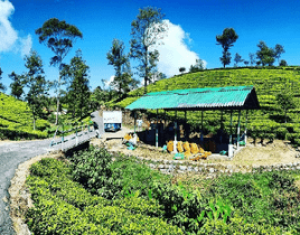
Lipton's Seat
Lipton’s Seat is the chosen viewpoint of Sir Thomas Lipton, the Scottish businessman who, like so many other British colonisers, saw the profit that could be made from buying into Ceylon’s blossoming tea industry in the 19th century. One of the most spectacular viewpoints in the Sri Lanka highlands, it offers a stunning and majestic panorama of rolling lush green tea fields framed by dramatic mountains and it is said that you can see all the way out to seven of Sri Lanka’s provinces. It is a beautiful place to spend a relaxing morning.
Visitors can walk or drive up to Lipton’s Seat. To journey to the lookout on foot, set out from the Dambatenne Tea Factory and follow the narrow, paved road (which is sign-posted) and trek for approximately 7km through picturesque tea estates dotted with tea pickers.
Duration: 2 hours
Best time: Year-round
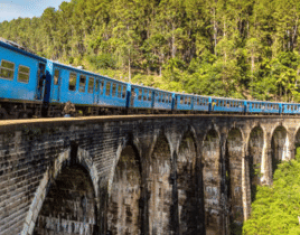
Nine Arch Bridge
Nine Arch Bridge in the Sri Lanka highlands town of Ella regularly takes centre stage in one of the most iconic pictures in the hill country. It is part working railway viaduct, part tourist photo opportunity. This setting, beloved by thousands of Instagram accounts, somehow conveys the relaxed vibe that makes Sri Lanka one of the most treasured holiday destinations in the world.
Duration: 2 hours
Best Time: Year-round
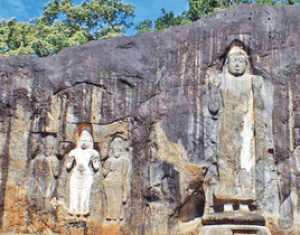
Buduruwagala
The giant Buddha figure – thought by some scholars to be the tallest in the world – is most impressive above the waist, the lower part being in rough condition. The raised right hand indicates kindness and freedom from fear. A slight orange hue suggests that image was once painted.
The Buddha is flanked by three smaller statues on each side. The figures on the right are most interesting. They are the Avalokiteshvara Bodhisattva, who granted succour to the poor and helpless; the Goddess Tara, who reputedly had the power to prevent natural disasters and disease; and Prince Sudhana, whose task was to guide young people towards the path of righteousness. All of these are figures from the Mahayana Buddhist tradition.
Duration: 1 hour
Best Time: Year-round
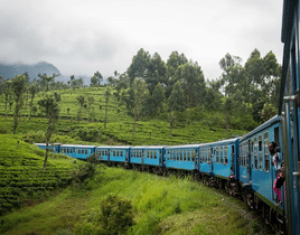
Kandy to the Hill Country by train
Train travel in Sri Lanka can be an adventurous experience and the morning railway journey from Kandy to the highlands is one of the greatest train rides in the world. The Sri Lanka Railways – the government railway network, which was first started in 1864 during the colonial period, covers a wide network of routes that spreads across the island. Travel by rail to Hatton, Dickoya, Nuwara Eliya or Ella, climbing up to 6,000ft above sea level, and enjoy the spectacular scenery unfolding around you. The dramatic landscape of the highlands stirs the senses as you wind past lush tea plantations, majestic peaks and rushing waterfalls. Your chauffeur-guide will drop you at the station and help you with your tickets, transport your luggage for you and meet you at the station at the other end. For more information on how to book tickets, please see our section on train travel in Sri Lanka.
Duration: 3 hours
Best Time: Year-round
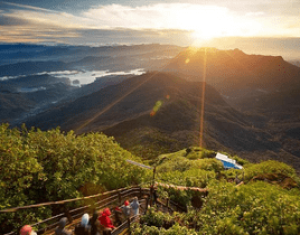
Adam's Peak
Climb Adam’s Peak, a mountain sacred to all four religious groups in Sri Lanka, in time to witness one of the most glorious sunrises in Asia. Sri Pada, or Adam’s Peak, is a 2,234m-high mountain which is sacred to all four main religious groups in Sri Lanka – Buddhists, Hindus, Muslims and Christians, all of whom variously claim the giant footprint at the top to be that of Lord Buddha, God Shiva, Adam or St. Thomas (the Christian apostle who preached in South India. Climbing the mountain is a popular pilgrimage, and a steady trickle of travellers join devotees between December and April to attempt the ascent. The climb is best started at about 2am – after a 3.5 hour hike, you will reach the summit and witness one of the most glorious sunrises in Asia. During pilgrimage season, strip lights and rudimentary stalls light the way to help keep you going all the way to the top. For many, this is a moving highlight of their stay in Sri Lanka and it is certainly one of the most awe-inspiring things to do in the island.
Duration: 7 hours
Best Time: December to April

Horton Plains National Park
Duration: 3 hours
Best Time: January to March
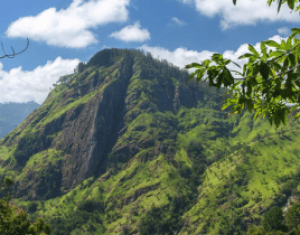
Little Adam's Peak
Little Adam’s Peak offers one of the finest viewpoints in the Sri Lanka Hill Country and is also part of a three-venue loop that can be done in one day. The youthful highlands town of Ella is the starting point for a short trek that can be extended to a three-section, 15km trek to include Little Adam’s Peak, Ella Rock and Nine Arch Bridge.
Although the climb to Little Adam’s Peak from Ella town is relatively easy, the views from the top of Little Adam’s Peak are sensational. Begin the climb with a gentle stroll through a sloping tea field, passing endless neat rows of terraced tea plants, before ascending a short stretch of winding steps up to the top of the peak.
Duration: 3 hours
Best Time: Year-round

Nuwara Eliya Golf Club
When you play golf in Nuwara Eliya you will be transported back a hundred years to Sri Lanka’s British colonial days – at times, you might even feel like you’re in the Scottish Highlands until you look closely at the tropical plants and flowers surrounding you. Built by a Scottish soldier of the Golan Highlanders for the British servicemen and officials stationed here in 1889, the course is truly spectacular, set 6,200ft above sea level, surrounded by rolling tea hills and framed by looming mountains. Nuwara Eliya – known as ‘Little England’ – is a charming hill station which was developed by British planters in the late 1800s. This is evident throughout the town: as well as a golf club, the British built a racecourse, tea factories, colonial hotels and planters’ bungalows, all of which seem to be frozen in time in a bygone era.
Duration: 2 hours
Best Time: Year-round
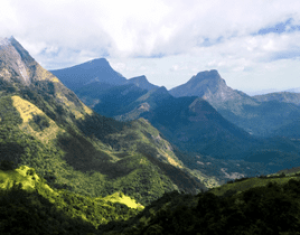
Hike in the Knuckles
This vast area covers 235 square kilometers and includes towering mountains, flowing waterfalls, quaint villages tucked into the hillsides, terraced rice fields, and a feeling of being surrounded by nature’s beauty at its best.
No matter your level of hiking skills, it is necessary to have a guide in this protected area recognized as a UNESCO world heritage site. Not having one could lead to getting lost or facing issues with the authorities. Our guide, a nature lover and expert in outdoor activities, can share interesting details about the trail or simply let you enjoy your own thoughts – whichever you prefer.
Despite Sri Lanka’s increasing popularity, this region remains mystical and less frequented, offering stunning panoramas and a sense of seclusion that will attract both seasoned and novice hikers alike.
Duration: 2 or 3 days
Best Time: February to August


